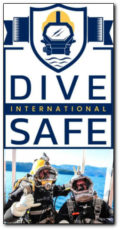CADC MAGAZINE ONLINE – Winter 2020-21: Problems and Solutions of Operating in a Covid 19 Environment
By CADC Admin ~ January 15th, 2021. Filed under: CADC MAG, Latest Diving News, Safety.
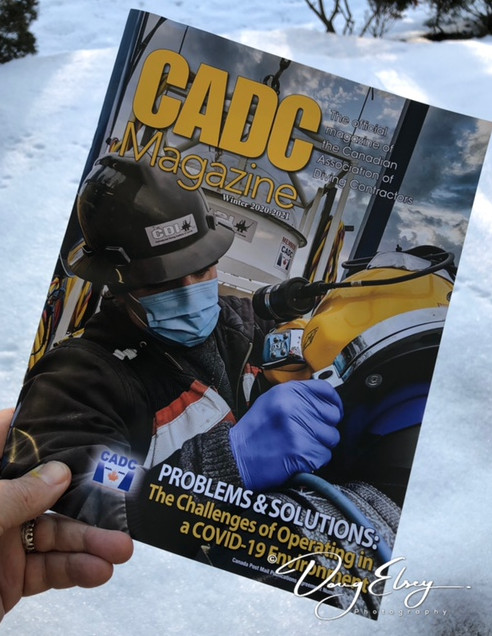 As this is being written (Oct 2020) , we have entered the second wave of the COVID-19 pandemic. Our industry—the provision of commercial underwater servicing—has been deemed an essential service in nearly all jurisdictions across North America. We are in the middle of it. We are on the front lines.
As this is being written (Oct 2020) , we have entered the second wave of the COVID-19 pandemic. Our industry—the provision of commercial underwater servicing—has been deemed an essential service in nearly all jurisdictions across North America. We are in the middle of it. We are on the front lines.
From diver training and certification, to the working diver on the end of the hose, all sectors and phases in our industry have met their challenges—and they’ve innovated in several ways to survive and thrive through this pandemic.
Diver training was immediately impacted, as all schools were ordered to shut down. The halt included dive schools, both private and publicly owned. Some of the private diving schools weren’t prepared for online leaning. It was new to them. And—unlike the publicly owned schools—they, in some cases, didn’t have the resources or infrastructure to teach online. Publicly owned schools were “shackled” by government mandates—and the bureaucracy that come with those mandates.
However, both types of schools pivoted, adapting and innovating as the situation unfolded across the country. Read Dealing with Dive School Closures During Quarantine on page 23 to learn more about the challenges dive schools faced and to see what they did about it. Divers are resourceful.
Diver certification organizations such as the Diver Certification Board of Canada had to dig deep to ensure schools were teaching to meet certification to CSA Diver Competency Standard Z275.4. Flip to page 27 to read The Impact of COVID-19: Changes in Process & Allowances for Certification, Training & Logbooks, which looks at the challenges they faced regarding certification.
On the actual operations front, dive service companies—deemed essential services—had to quickly adapt their operations to comply with COVID-19 health and safety protocol mandated by various provincial and federal jurisdictions. In some cases, jurisdictions imposed travel restrictions regionally and interprovincially in an attempt to curtail the spread of the disease. Travel between some provinces became restrictive. The “Atlantic Bubble,” consisting of the provinces of New Brunswick, Prince Edward Island, Nova Scotia and Newfoundland & Labrador, formed quickly to limit outside access to their combined borders. Quebec set up roadblocks to limit ground access from Ontario. Read about the challenges faced by dive service providers, and how they addressed those challenges, in Problems & Solutions: The Challenges of Operating in a COVID-19 Environment on page 16.
Our member spotlight in this issue shines on Canada Pump & Power, which offers its clients superb planning, technical knowledge and quality solutions to stringent international standards. Turn to page 29 to learn more about the company and why they value their CADC membership.
On page 31, photos of our members at work show, among day to day operations, the interesting, new ways of working to comply with COVID-19 restrictions and safety protocols.
Despite the sometimes almost-insurmountable challenges and economic impacts the coronavirus has had on our country and around the world, one thing is certain. Our industry is attuned to working in a hostile environment. It is what we do, and what we will continue to do. It’s what we’ve always done. Survey the situation. Make a plan. Suit up—and get after it.
Failure is not something divers tolerate well—nor does the client. Get the job done, and get it done safely. Our challenge has always been to figure it out. There is no other option.
And while we do our jobs, others are hard at it, too. Health professionals are hard at work and vaccines are on the way. Everyone has to job to do and everyone has an obligation to do their part to make it all work. Be safe. Stay safe. We’ve got this.
READ THE ONLINE VERSION OF THE MAGAZINE: https://tinyurl.com/CADC-MAG-WINTER-2020
DOWNLOAD: https://tinyurl.com/CADC-MAG-WINTER-20-21-DOWNLOAD



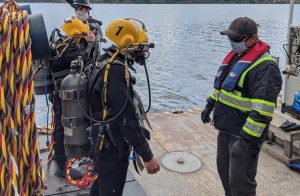 The health of our divers and support personnel has never been more important than it is now, during the COVID-19 pandemic. We know that “hot-swapping” of diving equipment is a common, and often necessary, practice used on a dive site. We also know that, unless appropriate proactive measures are taken, we run a real risk of compromising the health of our team members and jeopardizing the completion of the job.
The health of our divers and support personnel has never been more important than it is now, during the COVID-19 pandemic. We know that “hot-swapping” of diving equipment is a common, and often necessary, practice used on a dive site. We also know that, unless appropriate proactive measures are taken, we run a real risk of compromising the health of our team members and jeopardizing the completion of the job.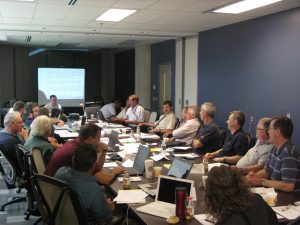 This year, 2020 marks the 50th anniversary of national health and safety standards for occupational diving and hyperbaric facilities in Canada. Let’s dive into the story behind the six standards in place today.
This year, 2020 marks the 50th anniversary of national health and safety standards for occupational diving and hyperbaric facilities in Canada. Let’s dive into the story behind the six standards in place today.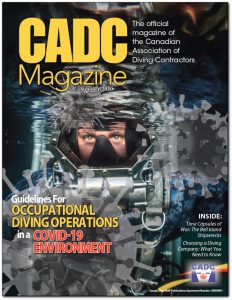 This issue of CADC Magazine has been a “stop the presses” moment. All planning for the publication—and our lives—ground to a halt with the COVID-19 pandemic.
This issue of CADC Magazine has been a “stop the presses” moment. All planning for the publication—and our lives—ground to a halt with the COVID-19 pandemic. These are links to articles and advisories on the effects of the COVID-19 virus issue pertinent to our Diving Industry. They will be updated continuously as we find more. These are posted only as a guideline and as an aid to distribute pertinent and relevant information. We cannot sift through what is true and frankly, what isn’t. There is a lot of information out there. It is up to the reader to check the accuracy of the posts for themselves.
These are links to articles and advisories on the effects of the COVID-19 virus issue pertinent to our Diving Industry. They will be updated continuously as we find more. These are posted only as a guideline and as an aid to distribute pertinent and relevant information. We cannot sift through what is true and frankly, what isn’t. There is a lot of information out there. It is up to the reader to check the accuracy of the posts for themselves.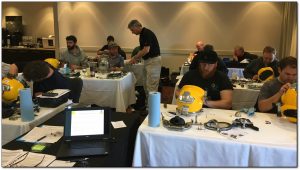 (Reprint: CADC MAG WINTER 2019-20)
(Reprint: CADC MAG WINTER 2019-20)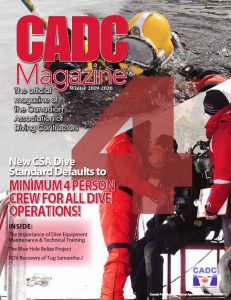 With a large number “4” on the cover of this issue of CADC Magazine, we make an in-your-face (read: in-your faceplate) point that if you are on a dive site in Canada and are concerned about safety, simply count the number of competent dive crew on the operation. If it isn’t four or more, ask the dive supervisor how the determination of crew size came about and if it mitigates the risk to the diver and the dive operation. Why does this crew size deviate from what is recognized as “best practice” by responsible diver operators in our industry?
With a large number “4” on the cover of this issue of CADC Magazine, we make an in-your-face (read: in-your faceplate) point that if you are on a dive site in Canada and are concerned about safety, simply count the number of competent dive crew on the operation. If it isn’t four or more, ask the dive supervisor how the determination of crew size came about and if it mitigates the risk to the diver and the dive operation. Why does this crew size deviate from what is recognized as “best practice” by responsible diver operators in our industry?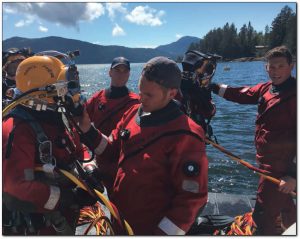 With the new release of Z275.2-20 (Diving Operations) in effect Jan 2020, the Canadian Standards emphasizes the default use of a minimum four-person crew to be required on all occupational diving operations – with only rare exceptions possibly allowed under a completed onsite risk assessment. The key to crew size is the this completed onsite risk assessment.
With the new release of Z275.2-20 (Diving Operations) in effect Jan 2020, the Canadian Standards emphasizes the default use of a minimum four-person crew to be required on all occupational diving operations – with only rare exceptions possibly allowed under a completed onsite risk assessment. The key to crew size is the this completed onsite risk assessment.


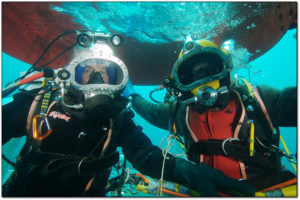 In March of 2004 the Canadian government introduced Bill C-45. The Bill added Section 217.1 to the Criminal Code which reads;
In March of 2004 the Canadian government introduced Bill C-45. The Bill added Section 217.1 to the Criminal Code which reads;
